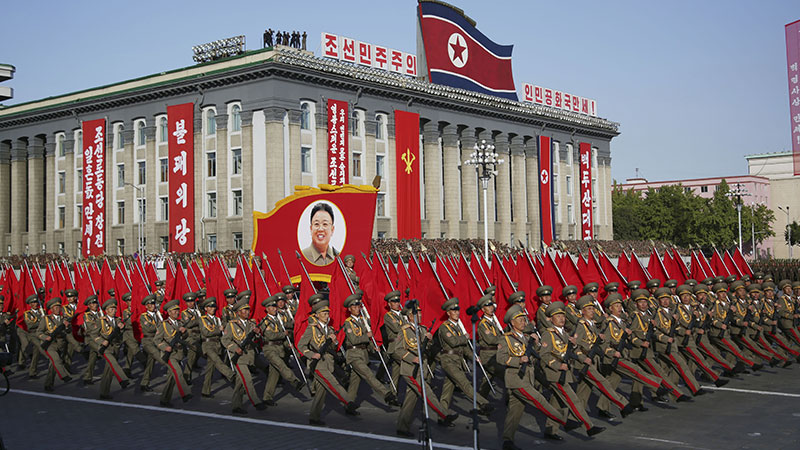How can North Korea, one of the world’s most heavily sanctioned nations, continue to earn enough foreign exchange to finance the development of its nuclear weapons? The 2018 documentary Dollar Heroes attempts to answer this question.
The investigative film, directed by Carl Gierstorfer and Sebastian Weis for The Why Foundation, alleges that North Korea skirts the stringent UN sanctions by running a secretive work programme that allows generating sufficient revenue for the state to continue fulfilling its nuclear ambitions. The film claims that the country’s leadership lures its workers with false promises, but once the workers enroll in the programme overseas, they find themselves toiling away for little to no pay, with their wages floating to the ruling Workers’ Party.
Party Duty
According to former South Korean government official Kim Kwang-Cheol, the foreign currency earned by North Korean labourers abroad is not used to strengthen the country’s public economy but to expand its nuclear programme and boost the so-called «palace economy», with the substantial share of wealth flowing into the hands of North Korean Supreme Leader Kim Jong-un and his family.
One of such labourers, a North Korean man working in the Russian city of Vladivostok, confides in the film that his fellow countrymen working abroad, known as «dollar heroes», sometimes earn as little as 50 US dollars a month, or are even left with nothing, after paying a mandatory «Party Duty».
they find themselves toiling away for little to no pay, with their wages floating to the ruling Workers’ Party.
The documentary asks bold questions, relying on experts for some answers that propel the investigation further. One of the experts, historian of Korea and Northeast Asia at Leiden University Remco Breuker, brands North Korea as «the biggest illegal job agency in the world» that rents out tens of thousands of its labourers, totalling some 150,000 people across the world, according to expert estimates. China and Russia, which are believed to be the main destinations for North Korean workers, host around 100,000 and 40,000 «dollar heroes» respectively. However, the appetite for the low-cost North Korean labour goes far beyond the two countries, stretching from the UAE to the heart of Europe, Poland. «It is the export of the North Korean system abroad, and it works,» poignantly remarks the Dutch professor, adding that «it is exactly the same system, with or without the country.»
By featuring testimonials of North Korean workers and those who have defected, the film puts a human face on the issue. It drives home the horrors of the operation as we hear stories of the North Koreans who managed to escape and those who are still in hiding. Early in the film, we are introduced to Park, a North Korean man who was sent to Siberia several decades ago to drive trucks in the timber camp. The camera follows the man as he gets behind the wheel, yet this time he is in South Korea, the country where he fled to in 2005.

We revisit Park throughout the film as he is dining with his family that fled to the South a few years after him, or as he is taking a stroll with his son, a now-grown man of a free country. And as the night descends, Park recounts, «I saw a lot of people die at work.» His painful memory pierces through the silence that is shared between the two men as they sit alongside each other, watching fellow residents nonchalantly play tennis.
The «bad one»
As the film progresses, we are transported to several sites across the world where North Korean work brigades are believed to be stationed. Following the reports that North Korean brigades are seen in the Polish port city of Szczecin, the team of undercover journalists arrives at the Partnership Shipyard. Asked about the workers’ country of origin, the Polish security guard, unaware of a hidden camera, says succinctly, «From the bad one … [North Korea]. They are like us during Communism. You know why they are not allowed to talk […]. They are just supposed to work. Nothing else.»
The film probes the inner workings and the scale of the operation, and it does so well. Yet, I believe a discussion of further methods that the North Korean leadership deploys to evade the sanctions, including the use of front companies, would lend the film more gravitas.
It drives home the horrors of the operation as we hear stories of the North Koreans who managed to escape and those who are still in hiding.
One may also express certain reservations when it comes to the use of hidden cameras in the film. Undoubtedly, any filmmaker who tackles the topic of North Korea’s treatment of human rights faces difficult decisions amid scarce access to subjects who are willing to speak about their ordeal. The film takes steps to ensure that the people’s safety is not undermined, either by distorting their voices or by blurring their faces, or both. Nevertheless, one must not overlook the extent of risks that such methods might pose.
Why?
The documentary draws to a close, leaving us with a string of important questions. Why do UN sanctions fail to eradicate North Korea’s exploitative operations? And why do we choose to look the other way as North Korean work brigades continue operating across the world? These ‘why’ questions demand an answer.






